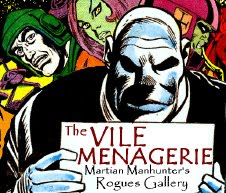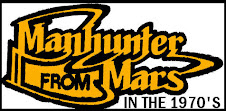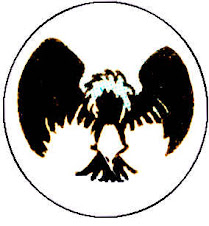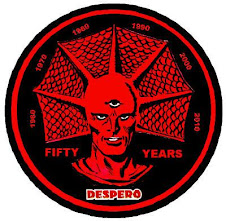
Doctor Trap fared better than Mister Bones, probably because of his more truncated and Manhunter-specific history. J'Onn J'Onzz did end up part of his origin, even if only in a roundabout way. Still, 60% of ten votes is a modest mandate.
As I've surely noted more times on this blog than anyone ever wanted to hear, the Vile Menagerie name was born in the late '90s on a WebTV fan page where my base of knowledge about Martian Manhunter rogues started with contemporaneous publishing and worked backward. Asmodel debuted in a 1997
JLA two-parter, and his whole history to that point was five comics, so he was one of the easiest, earliest (and therefore arguably one of the first premature) inclusions into the menagerie. I find it appropriate that we end 2012 with Asmodel as the last subject to face the trials of SurVILEvor Island.

When
Justice League Task Force writer Christopher Priest took on the new assignment of
Hawkman in 1996, he didn't know that he would only be allowed three issues to bring the series to a close and seal the drum on a character labelled "radioactive" to continuity by DC editorial. Priest liked his titles to be interrelated, and brought the Martian Manhunter (and 1997
Special cover and interior artists Howard Porter and Mike Collins) in to wrap things up. Similarly, he was blindsided when editorial decided to arbitrarily cancel all three current Justice League titles to set the stage for a relaunch. It was a very bad year to be on the B-list. Sixteen years later, many of the characters from those titles haven't made significant appearances anywhere else. Hawkman's being consigned to a literary limbo was kinder than the practical one where Zan and Jayna still reside.

Anyhow, Katar Hol had just been disposed of when Grant Morrison and Howard Porter (him again!) revived the Silver Age League line-up with postmodern flair for the monster hit
JLA. Morrison decided that since the prior incarnation of Hawkman had become toxic, it might be time to offer a modern age interpretation of the concept as revolutionary as those overseen by Julie Schwartz when he mined 1940s trademarks for 1960s hits. Mainstream comics have no stomach for actual permanent change though, and were only putting Hawkman on ice until the stink of
Hawkworld and
Zero Hour left him, so Morrison's take on a Hawkman as fallen angel amidst the Lord's host was distanced from the source material to become simply Zauriel.

Not-Hawkman needed his own nemesis to get the ball rolling though. Zauriel had fallen from grace by falling in love with the human woman he was tasked to guardian, which conveniently made him a non-credible witness to a planned rebellion in Heaven led by the King Angel of the Bull Host. Asmodel needed to silence Zauriel all the same, and this murderous pursuit caused him to cross paths with the Justice League. The Martian Manhunter was one of the members who clashed with Asmodel's renegade angels. Memorably, and tellingly of his status in the universe, a weary and singed Alien Atlas was told to "stand down" by Superman, who proceeded to wrestle with Asmodel while Green Lantern Kyle Raynor stared in awe. Kal-El is Jacob becoming Israel; J'Onn J'Onzz merely Esau the red-tinged and rough other brother who plays his part and is then set aside.

The not-yet-infamous Mark Millar wrote a Zauriel mini-series in all but name with frequent period Martian Manhunter illustrator Ariel Olivetti called
JLA: Paradise Lost that expanded the story. As part of a revenge play by Asmodel, he sucker-punched J'Onn J'Onzz to death. A major throughline of the narrative was that while his JLA buddies tried to revive J'Onn J'Onzz, his spirit was in Heaven aiding Zauriel in his conflict with Asmodel. J'Onzz returned from the hereafter at an inopportune point, leaving the final resolution up to Zauriel, the story's star. Once again, Asmodel was the heel, Martian Manhunter the jobber, and only the face changed from story to story. Of course, Zauriel himself swiftly proved to be "enhancement talent," but couldn't even die in Morrison's climactic
JLA arc "World War III" with the credibility of Aztek, and subsequently served as a "green-ham-n-egger" in DC magical collectives. I guess it's a tribute of a sort that Zauriel was like the Martian Manhunter of the Shadowpact, or something.

In his first gambit, Asmodel teamed up with Neron, a demon lord with established ties to Martian lore that were never elaborated upon. The same could be said of any lasting role for Asmodel as a thorn in Martian Manhunter's side. Asmodel merged with the Spectre Force to freeze Hell over in the unloved event mini-series
Day of Judgment, and continued in his role as subordinate to Neron in the similarly dismissed
Reign in Hell. The lion's share of Asmodel's career was played out by 1999, and the Sleuth from Outer Space has had no role in it since. The supernatural is one of the few genres that isn't a comfortable fit for the Martian Marvel, and lots of comic readers in general would rather not play around in Judeo-Christian-Islamist lore. I'd like to see red planet theology toyed with more, but direct comparison invites controversial knee jerk reactions better suited to Vertigo (to the degree that brand is relevant anymore) than the DCU. At a conceptual level, the Martian Manhunter and Asmodel are simply incompatible, and the stunt of "killing" J'Onn J'Onzz just set the precedent for the broad net of varied culpability cast over the gang murder of the hero in
Final Crisis. Maybe someday, someone will make the Alien Atlas die like they really mean it, instead of just killing the only vulnerable hero in the room because he's there.
 Doctor Trap fared better than Mister Bones, probably because of his more truncated and Manhunter-specific history. J'Onn J'Onzz did end up part of his origin, even if only in a roundabout way. Still, 60% of ten votes is a modest mandate.
As I've surely noted more times on this blog than anyone ever wanted to hear, the Vile Menagerie name was born in the late '90s on a WebTV fan page where my base of knowledge about Martian Manhunter rogues started with contemporaneous publishing and worked backward. Asmodel debuted in a 1997 JLA two-parter, and his whole history to that point was five comics, so he was one of the easiest, earliest (and therefore arguably one of the first premature) inclusions into the menagerie. I find it appropriate that we end 2012 with Asmodel as the last subject to face the trials of SurVILEvor Island.
Doctor Trap fared better than Mister Bones, probably because of his more truncated and Manhunter-specific history. J'Onn J'Onzz did end up part of his origin, even if only in a roundabout way. Still, 60% of ten votes is a modest mandate.
As I've surely noted more times on this blog than anyone ever wanted to hear, the Vile Menagerie name was born in the late '90s on a WebTV fan page where my base of knowledge about Martian Manhunter rogues started with contemporaneous publishing and worked backward. Asmodel debuted in a 1997 JLA two-parter, and his whole history to that point was five comics, so he was one of the easiest, earliest (and therefore arguably one of the first premature) inclusions into the menagerie. I find it appropriate that we end 2012 with Asmodel as the last subject to face the trials of SurVILEvor Island.
 When Justice League Task Force writer Christopher Priest took on the new assignment of Hawkman in 1996, he didn't know that he would only be allowed three issues to bring the series to a close and seal the drum on a character labelled "radioactive" to continuity by DC editorial. Priest liked his titles to be interrelated, and brought the Martian Manhunter (and 1997 Special cover and interior artists Howard Porter and Mike Collins) in to wrap things up. Similarly, he was blindsided when editorial decided to arbitrarily cancel all three current Justice League titles to set the stage for a relaunch. It was a very bad year to be on the B-list. Sixteen years later, many of the characters from those titles haven't made significant appearances anywhere else. Hawkman's being consigned to a literary limbo was kinder than the practical one where Zan and Jayna still reside.
When Justice League Task Force writer Christopher Priest took on the new assignment of Hawkman in 1996, he didn't know that he would only be allowed three issues to bring the series to a close and seal the drum on a character labelled "radioactive" to continuity by DC editorial. Priest liked his titles to be interrelated, and brought the Martian Manhunter (and 1997 Special cover and interior artists Howard Porter and Mike Collins) in to wrap things up. Similarly, he was blindsided when editorial decided to arbitrarily cancel all three current Justice League titles to set the stage for a relaunch. It was a very bad year to be on the B-list. Sixteen years later, many of the characters from those titles haven't made significant appearances anywhere else. Hawkman's being consigned to a literary limbo was kinder than the practical one where Zan and Jayna still reside.
 Anyhow, Katar Hol had just been disposed of when Grant Morrison and Howard Porter (him again!) revived the Silver Age League line-up with postmodern flair for the monster hit JLA. Morrison decided that since the prior incarnation of Hawkman had become toxic, it might be time to offer a modern age interpretation of the concept as revolutionary as those overseen by Julie Schwartz when he mined 1940s trademarks for 1960s hits. Mainstream comics have no stomach for actual permanent change though, and were only putting Hawkman on ice until the stink of Hawkworld and Zero Hour left him, so Morrison's take on a Hawkman as fallen angel amidst the Lord's host was distanced from the source material to become simply Zauriel.
Anyhow, Katar Hol had just been disposed of when Grant Morrison and Howard Porter (him again!) revived the Silver Age League line-up with postmodern flair for the monster hit JLA. Morrison decided that since the prior incarnation of Hawkman had become toxic, it might be time to offer a modern age interpretation of the concept as revolutionary as those overseen by Julie Schwartz when he mined 1940s trademarks for 1960s hits. Mainstream comics have no stomach for actual permanent change though, and were only putting Hawkman on ice until the stink of Hawkworld and Zero Hour left him, so Morrison's take on a Hawkman as fallen angel amidst the Lord's host was distanced from the source material to become simply Zauriel.
 Not-Hawkman needed his own nemesis to get the ball rolling though. Zauriel had fallen from grace by falling in love with the human woman he was tasked to guardian, which conveniently made him a non-credible witness to a planned rebellion in Heaven led by the King Angel of the Bull Host. Asmodel needed to silence Zauriel all the same, and this murderous pursuit caused him to cross paths with the Justice League. The Martian Manhunter was one of the members who clashed with Asmodel's renegade angels. Memorably, and tellingly of his status in the universe, a weary and singed Alien Atlas was told to "stand down" by Superman, who proceeded to wrestle with Asmodel while Green Lantern Kyle Raynor stared in awe. Kal-El is Jacob becoming Israel; J'Onn J'Onzz merely Esau the red-tinged and rough other brother who plays his part and is then set aside.
Not-Hawkman needed his own nemesis to get the ball rolling though. Zauriel had fallen from grace by falling in love with the human woman he was tasked to guardian, which conveniently made him a non-credible witness to a planned rebellion in Heaven led by the King Angel of the Bull Host. Asmodel needed to silence Zauriel all the same, and this murderous pursuit caused him to cross paths with the Justice League. The Martian Manhunter was one of the members who clashed with Asmodel's renegade angels. Memorably, and tellingly of his status in the universe, a weary and singed Alien Atlas was told to "stand down" by Superman, who proceeded to wrestle with Asmodel while Green Lantern Kyle Raynor stared in awe. Kal-El is Jacob becoming Israel; J'Onn J'Onzz merely Esau the red-tinged and rough other brother who plays his part and is then set aside.
 The not-yet-infamous Mark Millar wrote a Zauriel mini-series in all but name with frequent period Martian Manhunter illustrator Ariel Olivetti called JLA: Paradise Lost that expanded the story. As part of a revenge play by Asmodel, he sucker-punched J'Onn J'Onzz to death. A major throughline of the narrative was that while his JLA buddies tried to revive J'Onn J'Onzz, his spirit was in Heaven aiding Zauriel in his conflict with Asmodel. J'Onzz returned from the hereafter at an inopportune point, leaving the final resolution up to Zauriel, the story's star. Once again, Asmodel was the heel, Martian Manhunter the jobber, and only the face changed from story to story. Of course, Zauriel himself swiftly proved to be "enhancement talent," but couldn't even die in Morrison's climactic JLA arc "World War III" with the credibility of Aztek, and subsequently served as a "green-ham-n-egger" in DC magical collectives. I guess it's a tribute of a sort that Zauriel was like the Martian Manhunter of the Shadowpact, or something.
The not-yet-infamous Mark Millar wrote a Zauriel mini-series in all but name with frequent period Martian Manhunter illustrator Ariel Olivetti called JLA: Paradise Lost that expanded the story. As part of a revenge play by Asmodel, he sucker-punched J'Onn J'Onzz to death. A major throughline of the narrative was that while his JLA buddies tried to revive J'Onn J'Onzz, his spirit was in Heaven aiding Zauriel in his conflict with Asmodel. J'Onzz returned from the hereafter at an inopportune point, leaving the final resolution up to Zauriel, the story's star. Once again, Asmodel was the heel, Martian Manhunter the jobber, and only the face changed from story to story. Of course, Zauriel himself swiftly proved to be "enhancement talent," but couldn't even die in Morrison's climactic JLA arc "World War III" with the credibility of Aztek, and subsequently served as a "green-ham-n-egger" in DC magical collectives. I guess it's a tribute of a sort that Zauriel was like the Martian Manhunter of the Shadowpact, or something.
 In his first gambit, Asmodel teamed up with Neron, a demon lord with established ties to Martian lore that were never elaborated upon. The same could be said of any lasting role for Asmodel as a thorn in Martian Manhunter's side. Asmodel merged with the Spectre Force to freeze Hell over in the unloved event mini-series Day of Judgment, and continued in his role as subordinate to Neron in the similarly dismissed Reign in Hell. The lion's share of Asmodel's career was played out by 1999, and the Sleuth from Outer Space has had no role in it since. The supernatural is one of the few genres that isn't a comfortable fit for the Martian Marvel, and lots of comic readers in general would rather not play around in Judeo-Christian-Islamist lore. I'd like to see red planet theology toyed with more, but direct comparison invites controversial knee jerk reactions better suited to Vertigo (to the degree that brand is relevant anymore) than the DCU. At a conceptual level, the Martian Manhunter and Asmodel are simply incompatible, and the stunt of "killing" J'Onn J'Onzz just set the precedent for the broad net of varied culpability cast over the gang murder of the hero in Final Crisis. Maybe someday, someone will make the Alien Atlas die like they really mean it, instead of just killing the only vulnerable hero in the room because he's there.
In his first gambit, Asmodel teamed up with Neron, a demon lord with established ties to Martian lore that were never elaborated upon. The same could be said of any lasting role for Asmodel as a thorn in Martian Manhunter's side. Asmodel merged with the Spectre Force to freeze Hell over in the unloved event mini-series Day of Judgment, and continued in his role as subordinate to Neron in the similarly dismissed Reign in Hell. The lion's share of Asmodel's career was played out by 1999, and the Sleuth from Outer Space has had no role in it since. The supernatural is one of the few genres that isn't a comfortable fit for the Martian Marvel, and lots of comic readers in general would rather not play around in Judeo-Christian-Islamist lore. I'd like to see red planet theology toyed with more, but direct comparison invites controversial knee jerk reactions better suited to Vertigo (to the degree that brand is relevant anymore) than the DCU. At a conceptual level, the Martian Manhunter and Asmodel are simply incompatible, and the stunt of "killing" J'Onn J'Onzz just set the precedent for the broad net of varied culpability cast over the gang murder of the hero in Final Crisis. Maybe someday, someone will make the Alien Atlas die like they really mean it, instead of just killing the only vulnerable hero in the room because he's there.






























4 comments:
Hmmm....this one is sort of thought provoking. The use of theological (lore) is uncomfortable to readers and writers of the genre, but for some reason it's only the good parts so to speak that are frowned on, underused, or misused by overplay.
The magic realm and devils, hell and the such are all over ccomics. it's embraced by fans and writers without having to have the opposite force represented.?.
As far as this guy being in the menagerie (which is the coolest name for a villains rogues list ever) it's possible that it could work. Asmodel is a fallen angel who should now not be allowed back into Heaven. Earth or someplace else is now where he lives. So as just a powerful villain you could make the case that he belongs in the Vile Menagerie.
OA1, there's no doubt that Asmodel is a powerful villain, and the more comic-bookey arch exploration of Christian cryptozoology previously done with the character is fine for mainstream comics. My doubt comes from how that works in a Martian Manhunter context.
If you use Asmodel to explore J'Onn J'Onzz's faith, it by extension either trivializes Martian religion (because Christianity is "real") or trivializes Christianity (by disparaging it in comparison to a wholly fictional belief system.) By having an embodiment of Judeo-Christian-Islamic divinity as a bad guy, and setting up a non-believer as the good guy, you subtextually attack the faith of the majority of comic book readership. When Superman wrestles Asmodel, it's truth, justice and the American way against a perverted agent of "American" faith. When you trade in a Martian, the altered chemistry demands a deeper exploration, and likely an implied criticism of faith that is either tricky to pull off in "straight" comics or boring when the creators simply chicken out of it.
The other problem is that Martian Manhunter is a science-fantasy character, like Superman. In the case of the Man of Steel (emphasis on man) there's a heightened vulnerability to magic, which pretty much demands that he mingle with supernatural elements, because it takes him out of his comfort zone. I like when the same thing happens to Batman, because he already looks like an unnatural creature, but his lack of powers and firm belief in science means he's uprooted from his turf.
In the case of the Alien Atlas, he's already on the fringes of believability, and tends to work best as a fantastic element in a more grounded setting. Manhunter is already a seven foot green shapeshifting extra-terrestrial who has or can mimic any power in the book. He's already too close to being magical himself, so sending him to Heaven or Hell completely divorces him from meaningful human experience, especially at the scale Asmodel works his mojo. It gets too big to appreciate.
I voted No on Asmodel. I think that exploring J'Onn's belief systems work better, and it is very hard to pull off a villain like Asmodel who is tied into real world faiths for the reasons you have listed. I think that J'Onn would respect the beliefs of others, perhaps seeing them as valid as his own as some people in the real world do. (As previously mentioned on the blog, I am a practicing Reform Jew who views my tradition as one of many and that the righteous of all nations and worlds have a place in the world to come. However, I know that there are many people who see their faith as the one true way.)
It is hard to do the supernatural with J'Onn, and it would take a talented writer to do so very well. (Neil Gaiman comes to mind -- good luck getting him to do anything beyond the Sandman story coming up.) So, I think J'Onn meeting Lord Hroonmeer and Lord L'Zoril would be fitting. (Whether they are indeed the Endless is something to be decided in the New 52. I would prefer that they be so that J'Onn's beliefs encompass the Endless and the being above them.)
In general, I think that the supernatural is a hard fit for J'Onn but if it is done, it has to be done very well. Still, I think that J'Onn can be shown as having his beliefs and respecting those of others. Perhaps one thing he can do when he is more public is help people on Earth learn about his culture and other alien cultures. (I imagine that examining the belief systems of a truly alien being like J'Onn would be fascinating.)
Yes to all of that.
Post a Comment